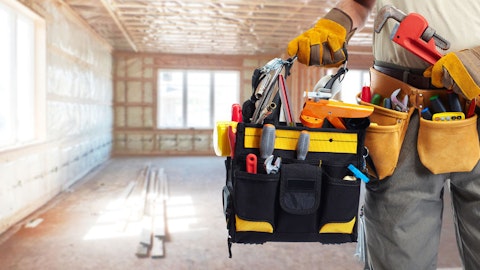Adam Baumgarten: Good morning, everyone. Couple of question on price increases, at this point, do you guys expect the manufacturers of the fibre glass manufacturers to announce additional price increases at some point this year?
Jeffrey Edwards: Certainly, they still are experiencing inflationary circumstances, let’s just say in certain parts of it from an input perspective, etcetera, although there’s maybe a little bit of weakening certain instances and freights other things, but, we’ll see. I guess I mentioned earlier, rules is type that’s not so much. So, I’m certainly would like to, if I believe that about it.
Adam Baumgarten: Got it. Okay, makes sense.
Michael Miller: Actually, there might be one additional price increase announcement this year, but obviously, we don’t know that their decision and how they’ll make it, and I think it will completely depend upon how does the market unfolds.
Adam Baumgarten: Yeah, okay, make sense and then just searching gears to commercial. I have a slide in the deck that came out this morning about three areas outside the quote core that you seem to be targeting with expansion joints through frustration and building restoration. I guess, question, are you currently in those areas and if not, is that you know an acquisition opportunity for those areas of focus?
Jeffrey Edwards: We’re just looking at different scopes of work. So it’s not stuff that we’re doing a lot of right now, but it’s just a question of what we’re — as we’ve talked on previous calls, we haven’t been — we’ve been disappointed in the financial performance of the heavy commercial operations. We expect to see pretty significant meaning in those operations over the course of ’23 and we’re looking at different scopes of work that will continue to help that improvement in the heavy commercial, which just at levels that given the growth that we’ve seen across all of the other business, the heavy commercial business is across 6% of overall revenue. So it’s not a significant component, but it’s an important component and we do think that it presents some interesting long term growth opportunities for us.
Operator: Our next question is from Phil Ng with Jefferies. Please proceed.
UnidentifiedAnalyst: Hey, good morning. This is Maggie on Phil. First, I guess, could you talk about your backlogs or maybe even more broadly, the industry backlogs, and kind of contextualize that units under construction metric being at these historic highs and how that kind of translates to volumes for you and how far that carries you into 2023?
Jeffrey Edwards: Well, I think right now, when you’re looking at the units under construction, you definitely have to make the distinction between single family and multifamily. Multifamily is really at an unprecedentedly high level right now. It is that multifamily unit backlog is actually larger than the single family, which I don’t think there are very many times in history where that has actually happened. So we believe that from an industry perspective, the backlog in multifamily is multi here at this point and as we said earlier, in a previous question or an answer to a previous question, we do believe that we’ll see and we think we need to see improvement in multifamily completion through the course of ’23. As it relates to the single family, it still is in that sort of 700,000, 750,000 unit range, which we think is reasonably healthy that theoretically implies if you had a more normalized multifamily backlog, probably like a 1.2 million or so pace for completion and well that’s below what most people would expect to be sort of a long term average of 1.5 million.
It’s still is a very comfortable level. On the single family side, in terms of what that backlog means for the industry, as we said again, in an answer to a previous question, a lot is going to depend upon the spring selling season, which is looking very encouraging right now, but given the decline that we’ve seen in the past a couple of months even longer, permits and stars, I think it’s logical to assume that you would have an impact relative to single family completions as we go through the end of the second quarter and into the — into the third quarter, potentially. Again, I’m going to carry out that statement though based on what happens with the spring selling season and how quickly the builders, which we think is pretty quickly, how quickly builders can react to what is potentially going to be a solid order growth.
UnidentifiedAnalyst: Okay, great. Thanks for all of that color, and then I guess on that. it’s been touched on a few times on the call so far, kind of the more recent optimism from the builders and I think late last year, coming into this year, the consensus was kind of we would need to see interest rates come down or at least stabilize or some progress on getting home prices at a more affordable level for these mortgage rate levels to really see a rebound in housing demand, but we haven’t really seen significant progress on either of those. So you know from your conversations with customers, what’s their sense, what are they attributing this more recent strength to and how sustainable do they see that?
Jeffrey Edwards: I think it’s more indicative of the idea that we haven’t even — we never did yet get back to stabilize kind of a 1.5 million type production on residential and so from that perspective, it’s underbuilt in it — there was only so long that the market could sit on the sidelines at least, although I’ve heard that, a lot of what’s happening is that, there wasn’t — they have picked up a smidge again too, but they pulled back from seven close to the six. There’s been maybe limited interest in adjustable rate mortgages unlike maybe in the past I heard that. But I think there’s been an offer of buydowns from the builders, but that many times it gets somebody in the door, but they ultimately end up not using it and still go ahead and end up as not only a traffic unit, but as a buyer.
I know anecdotally from the fact that we’re selling a few things that some buyers are clearly looking at the idea that if they could do a one year or two year or have been a three year with no penalties to get out of it, they can kind of ride through this period of time here, but they’ve got to kind of move on with their life, right, and they’ll revive as soon settle down here. It was the next hopefully 12 to 24 months.
Michael Miller: Yeah, I think the home buyer is adjusted and they’re accepting the new reality, and I think people have come to groups of the fact that they’re not going to get a 3% mortgage, but they still need some place to live and their family is growing, or they got a new job and it goes on.
Jeffrey Edwards: For those of us that are pretty old, at least 60 in June, that’s not real, old enough, I guess 6% we’re in that range is pretty darn attractive historically speaking. It’s only those that have kind of been familiar with the last 15 years, 10 years or really 10 years or less, right, where there’s a rate that have been less way, that you’ve read so much about.
UnidentifiedAnalyst: Okay, got it. Thanks so much and good luck on the next quarter.
Operator: Our next question is from Jeffrey Stevenson with Loop Capital Markets. Please proceed.
Jeffrey Stevenson: Hi, thanks for taking my questions today. I was wondering if you could provide any additional color on how installation volumes trended throughout the quarter because volumes were a little lighter than anticipated and wondered if an earlier in the construction season around the holidays played any role in that or was it largely due to the tough completions comp you referenced earlier?
Jeffrey Edwards: Yes, it’s really more just the timing of when we’re doing work, quite frankly, and as we said earlier, and I think if you — looking at it on a full year basis, in terms of our volume growth of 5.5% versus total completions growth of 3.7% make sense and we will favor price over volume and we think that, that is the right decision and we have lots of experience where we give up volume in the short term, only to get it back because our competitors can’t perform to the level that our customers want. So we’re happy to be patient and wait for volume.
Jeffrey Stevenson: No, that makes sense, and then my second question is one of your primary differentiators as your asset light model and high variable cost structure, and I’m just wondering, as we move into the spring construction season, what indicators you’ll be following the determined whether you need to make any adjustments if demand improves or slows more than anticipated?
Jeffrey Edwards: Well, fortunately, because our cost structure, the bulk of our cost are material and install labor and they flex to the volume of jobs that we have and the job opportunity that we have. So we will — we continuously make adjustments to the installer workforce and the amount of material that we’re acquiring or purchasing knowing in advance what our expected volumes are. So, I would say that the macro information that is available is helpful to inform our outlook, but the most important thing that we run the business by is what’s going on at the local level on a day to day basis. It’s that constant communication with our customer about and what they’re expecting from a volume perspective and the jobs that they are on.
So it’s a content situation where we’re adjusting the business. Now, if we have, which is completely unexpected or not anticipated from our perspective, but if we do have an extended if the spring selling season is with us, which we do not expect, but if that’s the case, then we will continue to make adjustments, not just to the installer workforce and material purchase, but we will make adjustments to the other variable costs in the business, but right now, from all the information that we have and all the feedback that we receive from the field, we feel, constructive given a very uncertain environment.



